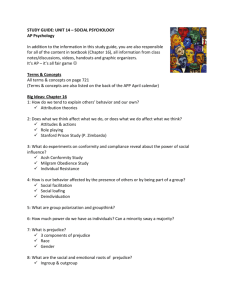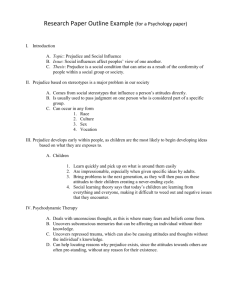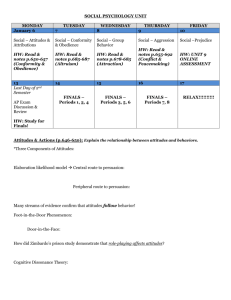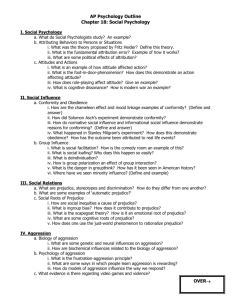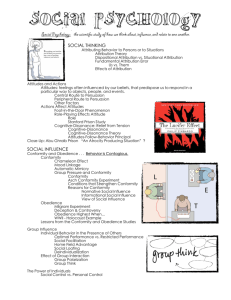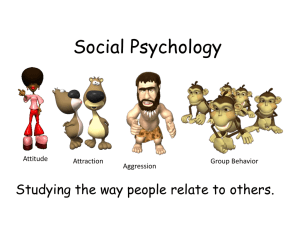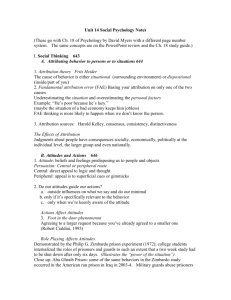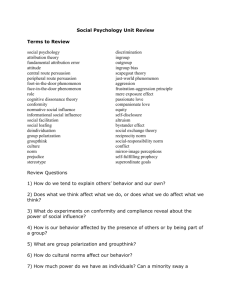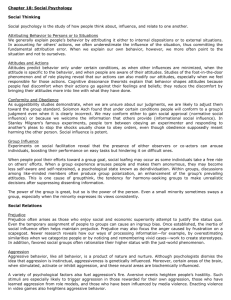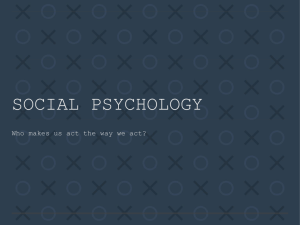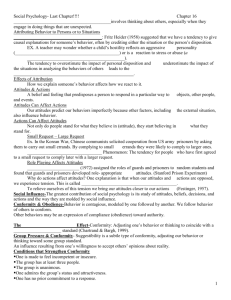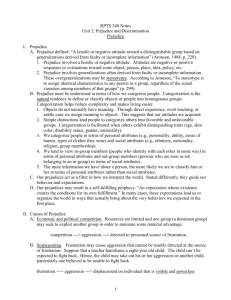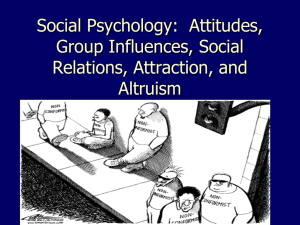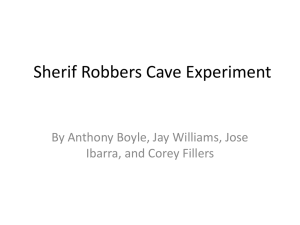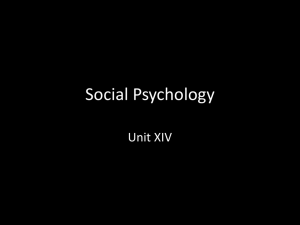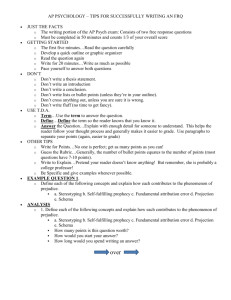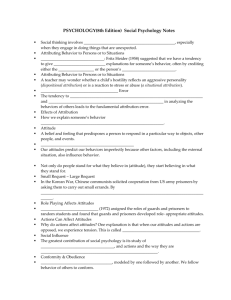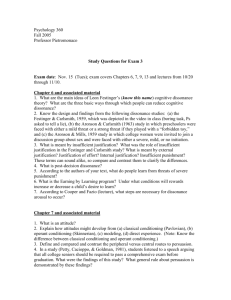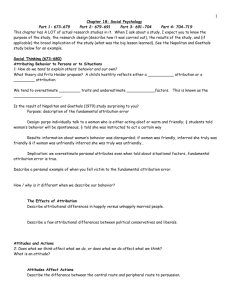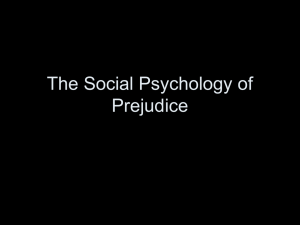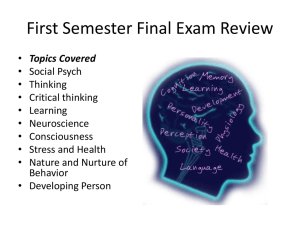Social Psychology
advertisement
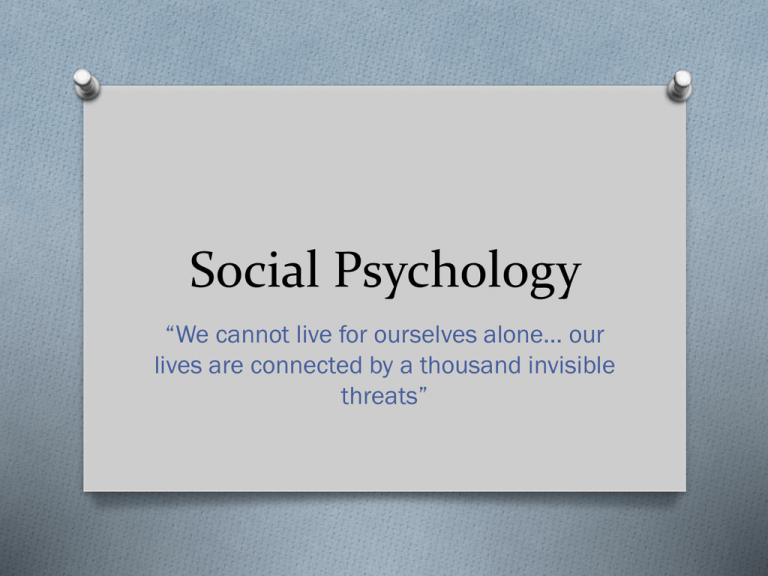
Social Psychology “We cannot live for ourselves alone… our lives are connected by a thousand invisible threats” Questions that Social Psychology aims to answer: O What causes a group of people to perform a genocide? O What drives terrorists to commit acts of hatred? O What factors influence the decision making of public leaders? O How do we form our attitudes about people and situations? Introduction O Social Psych studies… O How we think about one another O How we influence one another O How we relate to one another Do we attribute behavior to people or situations? O Is he absent because he is sick or lazy? O Does her smile signify romantic interest or does she smile at everyone? O Is he “snapping” because he is a shorttempered person or because he has had a stressful week? Attribution Theory O Fritz Heider (1958) O The Theory that we explain someone’s behavior by crediting either the situation or the person’s disposition O Many times our attributions are correct O Fundamental Attribution Error- At times we overestimate the influence of personality and underestimate the influence of situations O Example? Fundamental Attribution Error O Happens more so in Western Cultures O We attribute behavior of ourselves and people we know to situation more than we do with “strangers” O We are better at understanding the situation when we see the perspective of the “actor”; We can understand our own disposition when we see things from the “observer’s” perspective Example: Napolitan and Goethals (1979) O Experiment: Group of subjects spoke to an actress O Actress acted warm and friendly to some students, critical to the others O *half were told that her behavior was situational (i.e. that she was told to act that way) O Regardless, the students attributed this behavior to her disposition, not the situation Why is this so important? O Juries have to decide whether behavior was situational or the product of a person’s disposition O Interviews O Bosses and Managers O Couples O Why are you such a negative person? vs. You must be stressed at work O Politics: Liberals (situation) vs. Conservatives (disposition) Attitudes and Actions O What we do affects what we do? Vs. O What we think affects what we think? O Attitudes are feelings, often influenced by our beliefs, that predispose us to respond in a particular way to objects, people, and events. O If we believe like someone is malicious, we may act unfriendly and feel dislike Attitudes Affect Actions O Central Route Persuasion O When interested people focus on the arguments and respond with favorable thoughts O Happens when people are naturally analytical or involved in the issue O More durable O Peripheral Route Persuasion O When people respond to incidental cues, such as attractiveness or familiarity with a face (celebrity endorsements) Actions affect Attitudes O Foot-in-the-door phenomenon O A person who complies to perform a small action will later agree to a larger one O i.e. do a small favor for someone today and you’re more likely to do a larger favor for them in the future O To get someone to do something for you, “start small and build” O Doing a favor for someone you dislike may actually cause you to feel more positive about them Evidence O 17% of people agreed to put a large, hideous “drive carefully” sign in their front yard O When other homeowners were approached with a 3-inch sign first, 76% later consented to the large, ugly sign Food for Thought O You are driving on Rt. 17 South towards the Garden State Plaza to pick up some sweet kicks to wear this Saturday. The car behind you is flying at approximately 85 miles per hour. He is practically kissing your bumper when he maneuvers around you and swiftly passes you, only to get off the Ridgewood exit on two wheels less than a mile down the road. You think to yourself “what an impatient *&*#*@#”. O What error are you committing??? What could be the “situation”? Role-playing affects attitudes O When adopting a new role, a person strives to meet the expectations or social prescriptions of that role O Role will feel false until it “becomes” you. O “Fake it until you make it.”- AA O Zimbardo and the Stanford Prison Experiment (1972) O What we do, we gradually become. O Stanford Prison Experiment full video Cognitive Dissonance O We experience tension our attitudes and actions do not coincide O According to the cognitive dissonance theory, we tend to bring our attitudes into line with our actions O Was there ever something that you did that you weren’t 100% okay with but “convinced” yourself that it was the right thing or what you wanted? O Defense mechanism? Why does behavior or talk therapy work??? O Attitude-follows-behavior explains why therapies that emphasize talking in a more positive way may change the way people think and feel about themselves and situations Social Influence O Conformity O Compliance O Group Behavior Social Phenomena O We are chameleons who seek to blend with what’s natural around us O We follow dress codes, yawn together, laugh O O O O when others laugh, etc. Mood linkage- we feel happier around other happy people Empathetic people mimic more and are liked more- prone to unconscious mimicry Copycat violence Clusters of bomb threats, suicides, etc. Group Pressure and Conformity O Adjusting our behavior or thinking toward some group standard O Asch experiment O More than 1/3 of the time, college participants went along with the group O Individualistic countries have lower conformity rates during social experiments Conditions that Strengthen Conformity O One is made to feel O One has made no incompetent or prior commitment to insecure any response O The group has at O Others in the group least three people observe one’s behavior O Group is unanimous O One’s culture O One admires the strongly encourages group’s status and respect for social attractiveness standards Why do we conform? O Normative Social Influence O Influence resulting from a person’s desire to gain approval or avoid disapproval O Informational Social Influence O Influence resulting from one’s willingness to accept others’ opinions about reality O “Those who never retract their opinions love themselves more than they love truth”- Joubert O Sometimes we need to assume others are right Baron et al O When our decisions are important and are difficult, we are more likely to conform than if the task is easy Obedience O Milgram’s Obedience Experiment O 63% complied fully to deliver the final voltage O Even when told that the learned had a heart condition and displayed more agony, 65% complied O Obedience highest when: O Person given orders was close and was legitimate O The authority figure was supported by a prestigious institution O Victim was depersonalized or at a distance (another room) O There were no role models for defiance against experimenter Group Influence O Social facilitation O People swim faster when they compete than when O O O O they are alone (time trials) Drivers will accelerate faster at a green light when there is someone next to them Definition: Stronger responses are seen on simple or well-learned tasks in the presence of others However, when the task is difficult, people perform less well when observers or others are watching Conclusion: This phenomenon predicts that when around others, the most likely response will be facilitated (right on easy task, wrong on difficult) Group Influence O Social Loafing O The tendency for people in a group to exert less effort when pooling their efforts toward attaining a common goal than when individually accountable O Group case reading quizzes?!?! O Especially common in individualistic cultures Social Influence O Deindividuation O Abandoning normal restraints and self- awareness occurring in group situations that foster arousal and anonymity O i.e. food fights, senior cut day, flash mob O People are less self-conscious ad restrained when in a group situation Social Influence O Broken Window Theory O Broken windows (perceived destruction) open the door for further graffiti, crime, etc. O Zero tolerance would produce lower crime rates? O Northern Highlands Policies? Group Interaction O Group Polarization O Enhancement of a group’s prevailing tendencies O If a group is like-minded, discussion strengthens pre-existing opinions O Is this positive or negative? Group Interaction O Groupthink O When the desire for harmony and “good feelings” trumps realistic dissent among members of a group O No one steps in to give the reality check O i.e. The Perfect Storm O Fueled by overconfidence, conformity, selfjustification, and group-polarization Can an individual or minority shape the majority? O Although people often follow the majority publicly, they may privately develop sympathy for the minority view O Powers of the committed individual can sway the majority if the position is held unswervingly O Popularity vs. influence Social Relations O Prejudice O ‘Prejudgment” O An unjustifiable (and usually negative) attitude toward a group and its members O Usually involves stereotyped beliefs, negative feelings, and predisposition to discriminatory action O May be blatant or subtle (saying you’re not racist but being uncomfortable dating someone of the other race) Prejudice O Black motorists are often the majority of those pulled over, even in states where they are the minority O 1115 landlords received letters of interest from would-be tenants (fake) O Tyrell Jackson- 56% O Said Al-Rahman- 66% O Patrick McDougall- 89% O If you believe your father is more intelligent than your mother (without evidence), you have a gender prejudice!! O More people express wanting male babies, but “prefer” traits of women “Automatic Prejudice” Researchers believe that most of our prejudices are implicit and automatic O Implicit racial associations O Unconscious patronization O Lower standards O Race-influence perceptions O More likely to perceive a wallet as a gun in a simulated crime scene when person was black O “Seeing black” O The more stereotypical the features, the more “criminal” blacks are O Reflexive bodily responses in amygdala and facial muscles when exposed to a black face Social Roots of Prejudice O Social inequalities O Stereotypes rationalize inequalities (i.e. slavery) O Blame-the-victim dynamic O Poverty may increase crime level, which provides new grounds for prejudice O Ingroup and Outgroup O We often reserve intense dislike for outgroup rivals who are most like us (Portuguese and Spanish…. Highlands and ?) Emotional Roots of Prejudice O Implies “us” and “them”, breeding ingroup bias, or favoring one’s own group O Scapegoat Theory O Finding someone to blame when things go wrong O Our society’s scapegoat? History’s scapegoat? O Temporary frustration, failure, or insecurities intensify prejudice (need to boost selfesteem) Cognitive Roots of Prejudice O Categorization O We overestimate the similarity of those within other groups O Other race-effect, or own-race bias O We can better recognize our own faces and tend to think other ethnicities act and look more alike than they do O Vivid Cases O More intense crimes lead us to remember them, so if we have been exposed to one race committing more violent crimes we tend to over exaggerate the number of them in our minds O Example? Cognitive Roots of Prejudice O Just-World Phenomenon O “People get what they deserve” O The good are rewarded and the bad are punished? O Victims should be blamed (i.e. AIDS) O Aggression O Genetic O Neural O Biochemical Aggression: Influences O Genetic O Identical twins are similar in levels of aggression O Animals are bred to be aggressive (pitbulls) O Y chromosome O Neural O Amygdala facilitates aggression, frontal lobe inhibits O Biochemical O Hormones (i.e. testosterone), alcohol O Activities can enhance testosterone (handling gun) O Frustration-aggression principle O Frustration creates anger, which generates aggression O Pain, insults, foul odors, hot temperatures, smoke O Rejection O Video Games? Attraction O We do we befriend or fall in love with some people but not others? O Proximity- “familiarity breeds content” O Mere-Exposure Effect- repeated exposure to novel stimuli increases liking of them O We like computer-generated faces that are morphed with our own O Physical Attractiveness- rated as happier, healthier, sensitive, successful, socially skilled (not honest or compassionate, though) O Women spend more $ on cometics than education O “love looks not with the eyes, but with the mind”- people w/ good qualities become more attractive Attraction (cont.) O Similarity O More likely to marry someone w/ similar sounding name O Opposites retract O “Lovers should love many things together, not merely each other” O Reward Theory of Attraction O We will like those whose behavior is rewarding to us and less costly (i.e. long distance, etc.) Romantic Love O Passionate vs. companionate love O Passionate O Aroused state of intense positive absorption in another, usually present at the beginning of a love relationship O Two-factor theory of emotion? O Adrenaline makes the heart grow fonder O Companionate O Deep, affectionate attachment we feel for those with whom our lives are intertwined Key to Relationships O Equity O Both partners receive in proportion to what they give O Self-disclosure O Revealing intimate details about ourselves Altruism O Unselfish regard for the welfare of others O Bystander Effect O Diffusion of responsibility O The more people that are around, the less willing we are to help O We are more likely to help if: O Person appears to need and deserve help O Person is similar to us O We have observed someone being helpful O We aren’t in a hurry O We are in a small town or rural area O We are feeling guilty O We are focused on others and not preoccupied O We are in a good mood Norms for Helping O Social Exchange Theory O Our social behavior is an exchange process in which we maximize benefits and minimize costs O Reciprocity Norm O We should return help, not harm, to those who helped us O Social Responsibility Norm O We should help those who need our help (elderly, children, ill) O Subway incident? Social Traps: Prisoner’s Dilemma O Two men are arrested, but the police do not possess enough information for a conviction. Following the separation of the two men, the police offer both a similar deal—if one testifies against his partner (defects/betrays), and the other remains silent (cooperates/assists), the betrayer goes free and the cooperator receives the full one-year sentence. If both remain silent, both are sentenced to only one month in jail for a minor charge. If each 'rats out' the other, each receives a three-month sentence. Each prisoner must choose either to betray or remain silent; the decision of each is kept quiet. What should they do? Conflict and Peacemaking O Conflict O perceived incompatibility of actions, goals, or ideas O Social Traps O Situation in which the conflicting parties become caught in mutually destructive behavior Option 2 Option 1 Option 1 Option 1 $5 $5 $10 Option 2 -$5 $10 $0 -$5 $0 Real life examples of the social traps? O i.e. costs more money to “go green” and buy a fuel efficient car O Collective cost = everyone suffers from greenhouse gasses O Solve these problems with regulations, communication, and awareness Enemy Perceptions O Mirror-image perceptions O Mutual views held by conflicting people, when each side sees itself and ethical and peace and views the other as evil and aggressive O Examples? Peace-building O Contact O Work closely with other races, sexual orientations, and you will develop acceptance and reduce prejudice O Cooperation O Superordinate goals O Shared goals that override differences among people and require their cooperation O Remember the Titans? O Communication O Mediators replace win-lose mentality with win-win O Conciliation O GRIT- Graduated and Reciprocated Initiatives in Tension- Reduction O Arms race: “I reduce, you reduce”
